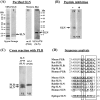Sarcolipin and phospholamban mRNA and protein expression in cardiac and skeletal muscle of different species
- PMID: 15801907
- PMCID: PMC1184547
- DOI: 10.1042/BJ20050068
Sarcolipin and phospholamban mRNA and protein expression in cardiac and skeletal muscle of different species
Abstract
The widely held view that SLN (sarcolipin) would be the natural inhibitor of SERCA1 (sarcoplasmic/endoplasmic-reticulum Ca2+-ATPase 1), and PLB (phospholamban) its counterpart for SERCA2 inhibition is oversimplified and partially wrong. The expression of SLN and PLB mRNA and protein relative to SERCA1 or SERCA2 was assessed in ventricle, atrium, soleus and EDL (extensor digitorum longus) of mouse, rat, rabbit and pig. SLN protein levels were quantified by means of Western blotting using what appears to be the first successfully generated antibody directed against SLN. Our data confirm the co-expression of PLB and SERCA2a in cardiac muscle and the very low levels (in pig and rabbit) or the absence (in rat and mouse) of PLB protein in the slow skeletal muscle. In larger animals, the SLN mRNA and protein expression in the soleus and EDL correlates with SERCA1a expression, but, in rodents, SLN mRNA and protein show the highest abundance in the atria, which are devoid of SERCA1. In the rodent atria, SLN could therefore potentially interact with PLB and SERCA2a. No SLN was found in the ventricles of the different species studied, and there was no compensatory SLN up-regulation for the loss of PLB in PLB(-/-) mouse. In addition, we found that SLN expression was down-regulated at the mRNA and protein level in the atria of hypertrophic hearts of SERCA2(b/b) mice. These data suggest that superinhibition of SERCA by PLB-SLN complexes could occur in the atria of the smaller rodents, but not in those of larger animals.
Figures






References
-
- MacLennan D. H., Asahi M., Tupling A. R. The regulation of SERCA-type pumps by phospholamban and sarcolipin. Ann. N.Y. Acad. Sci. 2003;986:472–480. - PubMed
-
- Asahi M., Kurzydlowski K., Tada M., MacLennan D. H. Sarcolipin inhibits polymerization of phospholamban to induce superinhibition of sarco(endo)plasmic reticulum Ca2+-ATPases (SERCAs) J. Biol. Chem. 2002;277:26725–26728. - PubMed
-
- Asahi M., Sugita Y., Kurzydlowski K., De Leon S., Tada M., Toyoshima C., MacLennan D. H. Sarcolipin regulates sarco(endo)plasmic reticulum Ca2+-ATPase (SERCA) by binding to transmembrane helices alone or in association with phospholamban. Proc. Natl. Acad. Sci. U.S.A. 2003;100:5040–5045. - PMC - PubMed
-
- Odermatt A., Becker S., Khanna V. K., Kurzydlowski K., Leisner E., Pette D., MacLennan D. H. Sarcolipin regulates the activity of SERCA1, the fast-twitch skeletal muscle sarcoplasmic reticulum Ca2+-ATPase. J. Biol. Chem. 1998;273:12360–12369. - PubMed
-
- Minamisawa S., Wang Y., Chen J., Ishikawa Y., Chien K. R., Matsuoka R. Atrial chamber-specific expression of sarcolipin is regulated during development and hypertrophic remodeling. J. Biol. Chem. 2003;278:9570–9575. - PubMed
Publication types
MeSH terms
Substances
LinkOut - more resources
Full Text Sources
Other Literature Sources
Molecular Biology Databases
Miscellaneous

